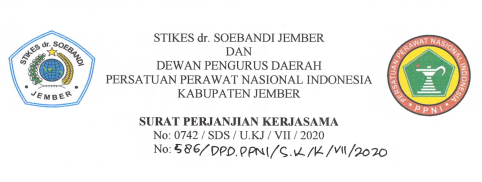The Relationship Between Nutritional Status And The Development Of Children Aged 4-60 Months
DOI:
https://doi.org/10.36858/jkds.v12i2.689Keywords:
Child Development, Nutritional Status, ChildrenAbstract
Child development is an important aspect of human life, especially in the early period of life, which is often referred to as the critical or golden period as the child's brain undergoes rapid growth. Developmental disorders in children under five, especially in terms of motor skills, have a long-term impact on their development, and a child's nutritional status has been shown to play a role in the process. Therefore, this study aims to determine the relationship between nutritional status and development of children aged 4-60 months in Jember Regency. The research method used was a quantitative correlational approach with a cross-sectional approach, involving a total of 57 children who had a Kartu Menuju Sehat (KMS) as the population. From the results of the formula calculation, the sample size was determined as 50 respondents using a non-randomized (non-probability) method, namely purposive sampling based on certain criteria. The research instruments involved the Kartu Menuju Sehat (KMS) to assess children's nutritional status and the Developmental Pre-Screening Questionnaire (KPSP) to identify children's development. The results of the chi-square statistical test revealed a significant relationship between nutritional status and development of children aged 4-60 months in Jember District. [ Children with good nutritional status show more optimal developmental progress, while children with poor nutritional status tend to experience slower or inappropriate development for their age. This finding supports theories that emphasize the importance of adequate nutrition for children's growth and development. Therefore, efforts to improve children's nutritional status should be a top priority in various child health and education programs. With the right understanding and action, we can help create a healthier and more potential future generation.
References
Adriani, & Wirjatmadi. (2017). Pengantar Gizi Masyarakat. Jakarta: Kencana.
Aprilasari. (2017). Penerapan Brain Gym untuk Meningkatkan Perkembangan Kognitif Anak Usia 4-6 Tahun di TK Marsudi Putro Yogyakarta. Skripsi STIKes Jenderal Achmad Yani Yogyakarta. [Link:
BPS. (2018). Profil Anak Indonesia 2018. Jakarta: Kementerian Pemberdayaan Perempuan dan Perlindungan Anak (KPPPA).
Marimbi, H. (2018). Tumbuh Kembang, Status Gizi Dan Imunisasi Dasar Pada Balita. Yogyakarta: Nuha Medika.
Ministry of Health Indonesia. (2022). Profil Kesehatan Indonesia 2022.
Napitupulu. (2018). Hubungan Status Gizi Dengan Perkembangan Motorik Kasar Anak Balita 3-5 Tahun Di Puskesmas Kelurahan Harjosari 1 Kecamatan Medan Amplas. Skripsi. Politeknik Kesehatan Kemenkes RI Medan.
Putriana, K., Pratiwi, E.A., & Wasliah. (2019). Hubungan Durasi dan Intensitas Penggunaan Gadget dengan Perkembangan Personal Sosial Anak Usia Prasekolah (3-5 Tahun) di TK Cendikia Desa Lingsar Tahun 2019. Jurnal Kesehatan Qamarul Huda, 7(2), 5-13.
Rivanica, R., & Oxyandi, M. (2018). Buku Ajar Deteksi Dini Tumbuh Kembang dan Pemeriksaan Bayi Baru Lahir. Jakarta: Salemba Medika.
Setianingsih, S. (2018). Dampak Penggunaan Gadget Pada Anak Usia Prasekolah Dapat Meningkatkan Resiko Gangguan Pemusatan Perhatian Dan Hiperaktivitas. Gaster | Jurnal Ilmu Kesehatan, 16(2), 191.
Supariasa. (2017). Penilaian Status Gizi. Jakarta: Egc.
Wuryani (2018). Bina Diri Tunagrahita Berbasis Multimedia Interaktif. Jakarta: Unj Press.
Yunita, L. (2021). Hubungan Status Gizi Dengan Perkembangan Motorik Kasar Anak Usia Prasekolah Di Wilayah Kerja Posyandu Bunga Maja Kecamatan Gunung Sari. Nutriologi: Jurnal Pangan, Gizi Dan Kesehatan, Volume 02, No. 02.
Downloads
Published
How to Cite
Issue
Section
License
Copyright (c) 2024 Jurnal Kesehatan dr. Soebandi

This work is licensed under a Creative Commons Attribution-NonCommercial-ShareAlike 4.0 International License.




